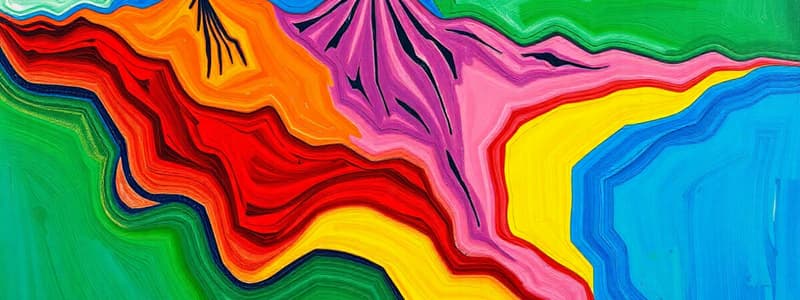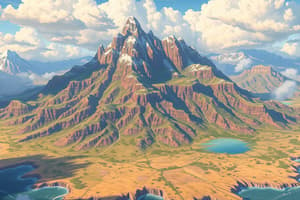Podcast
Questions and Answers
Which of the following is NOT a key area of focus within political geography?
Which of the following is NOT a key area of focus within political geography?
- State borders
- International relations
- Economic systems (correct)
- Political systems
What is the primary purpose of using GIS software?
What is the primary purpose of using GIS software?
- To compose musical scores
- To analyze and display geographic information (correct)
- To write fictional stories
- To create artistic landscape paintings
Which type of map is specifically designed to show spatial data?
Which type of map is specifically designed to show spatial data?
- Road map
- Thematic map (correct)
- Political map
- Topographic map
What does the study of geopolitics primarily explore?
What does the study of geopolitics primarily explore?
Which of the following is a major contemporary environmental issue?
Which of the following is a major contemporary environmental issue?
What is the primary focus of human geography?
What is the primary focus of human geography?
Which of the following is a crucial tool in modern geography?
Which of the following is a crucial tool in modern geography?
Which of these is a major landform?
Which of these is a major landform?
What is a key factor in climate systems?
What is a key factor in climate systems?
Which of the following is part of the hydrosphere?
Which of the following is part of the hydrosphere?
What concept does the biosphere explore?
What concept does the biosphere explore?
What influences population dynamics?
What influences population dynamics?
Which of the following influences settlement patterns?
Which of the following influences settlement patterns?
Flashcards
Spatial patterns of economic activities
Spatial patterns of economic activities
The arrangement of economic activities across different areas and its effects on communities.
Globalization
Globalization
The increased interconnectedness of countries through markets and production over recent decades.
Geopolitics
Geopolitics
The study of how political power is distributed geographically and its impact on international relations.
GIS Applications
GIS Applications
Signup and view all the flashcards
Urbanization
Urbanization
Signup and view all the flashcards
Geography
Geography
Signup and view all the flashcards
Physical Geography
Physical Geography
Signup and view all the flashcards
Human Geography
Human Geography
Signup and view all the flashcards
Climate Zones
Climate Zones
Signup and view all the flashcards
Hydrosphere
Hydrosphere
Signup and view all the flashcards
Population Distribution
Population Distribution
Signup and view all the flashcards
Settlement Patterns
Settlement Patterns
Signup and view all the flashcards
Economic Activities
Economic Activities
Signup and view all the flashcards
Study Notes
Introduction to Geography
- Geography studies Earth's surface, including physical features, human activities, and their interactions.
- It encompasses spatial and environmental aspects of our planet.
- Human geography focuses on human-environment and human-human interactions across space and place.
- Physical geography examines natural processes shaping Earth's surface.
- Geography investigates the spatial distribution of phenomena, explaining why things are located where they are.
- Geographic Information Systems (GIS) and remote sensing are crucial modern tools.
Physical Geography
- Landforms:
- Mountains, plateaus, and plains are major landforms, shaped by tectonic forces, weathering, and erosion.
- Plate tectonics, volcanism, and earthquakes are key to landscape formation.
- Climate influences landform evolution (e.g., glaciation).
- Climate:
- Complex climate systems involve temperature, precipitation, wind patterns, atmospheric pressure, and solar radiation.
- Climate zones (e.g., tropical, temperate, polar) have specific temperature and precipitation ranges.
- Global climate change is a substantial contemporary issue.
- Hydrosphere:
- Oceans, rivers, lakes, and groundwater comprise the hydrosphere.
- Water cycles (evaporation, condensation, precipitation) and water distribution are important.
- Rivers and oceans affect human activities and the environment.
- Biosphere:
- Earth's ecosystems (forests, grasslands, deserts) and biodiversity are studied.
- Interactions between organisms and their environment are examined.
- Environmental issues (deforestation, pollution) greatly affect the biosphere.
Human Geography
- Population:
- Population distribution, density, and growth are essential concepts.
- Birth rates, death rates, migration patterns, and economic opportunities impact population dynamics.
- Population distribution is often uneven, with clusters in certain regions.
- Settlement Patterns:
- Urbanization, rural depopulation, and rural-urban migration influence settlement patterns.
- Urban areas have unique challenges and opportunities.
- Rural settlements are often linked to agriculture and resource extraction.
- Economic Activities:
- Manufacturing, agriculture, services, and trade are crucial components of economic geography.
- Spatial patterns of economic activities and their community impacts are assessed.
- Globalization of markets and production has transformed economic activities in recent decades.
- Political Geography:
- State borders, political systems, and international relations are studied.
- The spatial distribution of political power and its consequences are examined.
- Geopolitics explores the interaction between politics and territory.
Geographic Skills
- Map Reading & Interpretation:
- Different map types (topographic, thematic) and their uses are understood.
- Symbols, scales, and projections are interpreted.
- Maps are used to analyze spatial patterns and relationships.
- GIS Applications:
- GIS software is used to collect, store, analyze, and display geographic information.
- Thematic maps and spatial models are created.
- GIS has applications in various fields (environmental management, urban planning).
- Data Analysis & Interpretation:
- Statistical methods analyze geospatial data.
- Spatial patterns and distributions are analyzed to draw meaningful conclusions.
- Data is presented effectively using appropriate cartographic and graphical methods.
Current Issues in Geography
- Environmental Issues:
- Climate change, pollution, deforestation, resource depletion, and sustainable development are critical contemporary issues.
- Geography plays a vital role in understanding and addressing these challenges.
- Globalization:
- Increased interconnectedness and interdependence of countries and regions are examined.
- Its effects on cultural exchange, economic development, and political systems are assessed.
- Geography examines the impact of globalization on diverse regions and populations.
- Urbanization & Development:
- Rapid urbanization's challenges and opportunities are explored.
- Urban planning, sustainable city development, and managing urban growth are analyzed.
- Uneven development between regions and countries is a significant concern.
Studying That Suits You
Use AI to generate personalized quizzes and flashcards to suit your learning preferences.
Description
Explore the fundamentals of geography, including physical and human aspects. Discover how landforms like mountains and plains are shaped by tectonic forces, weathering, and climate. Learn about the impact of geographic information systems in modern geography.



